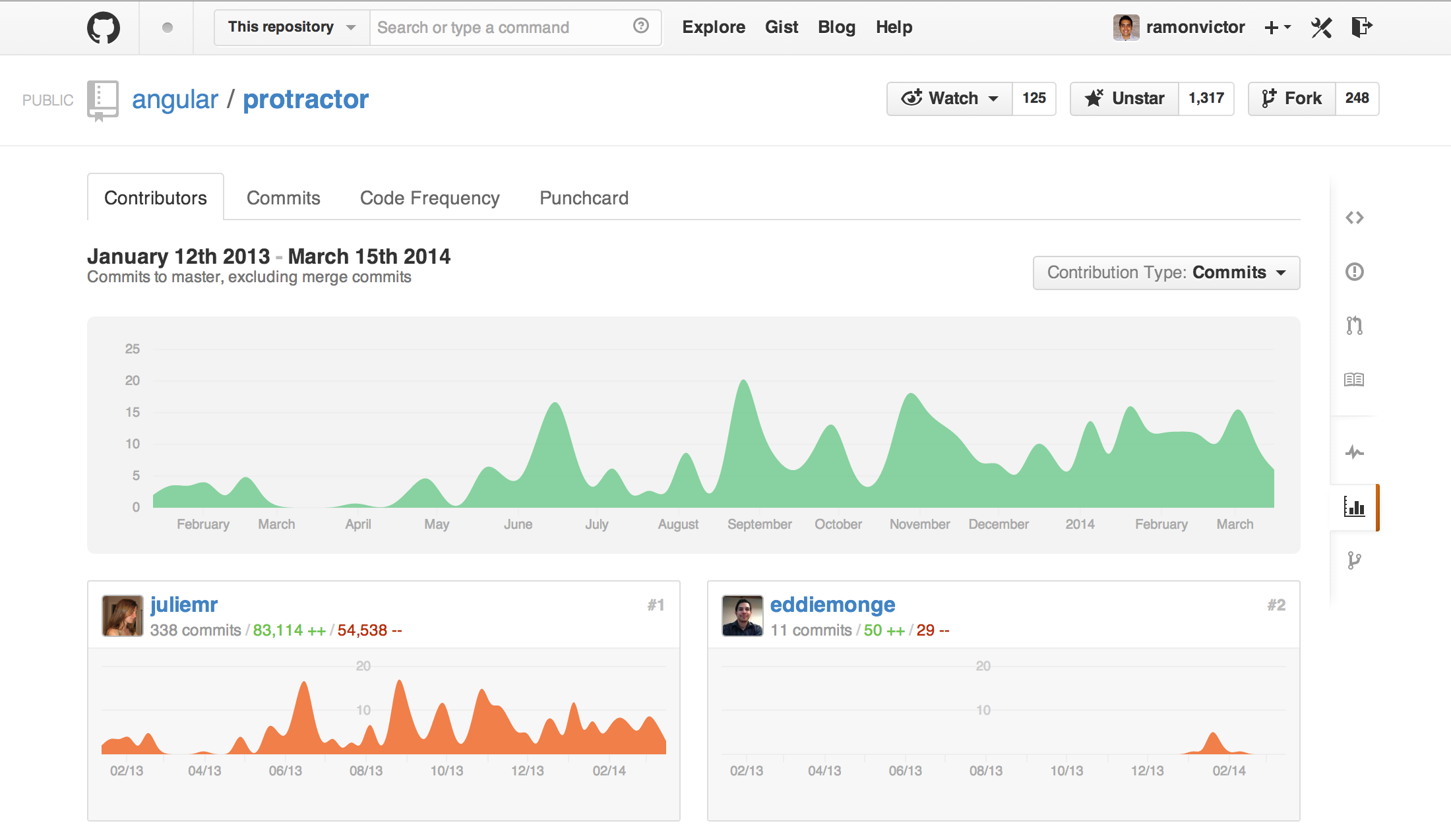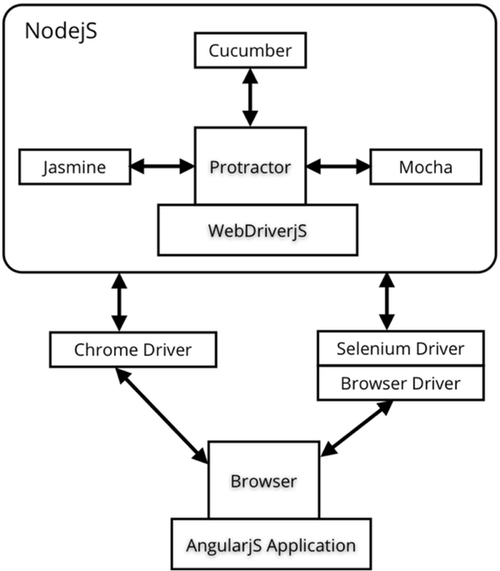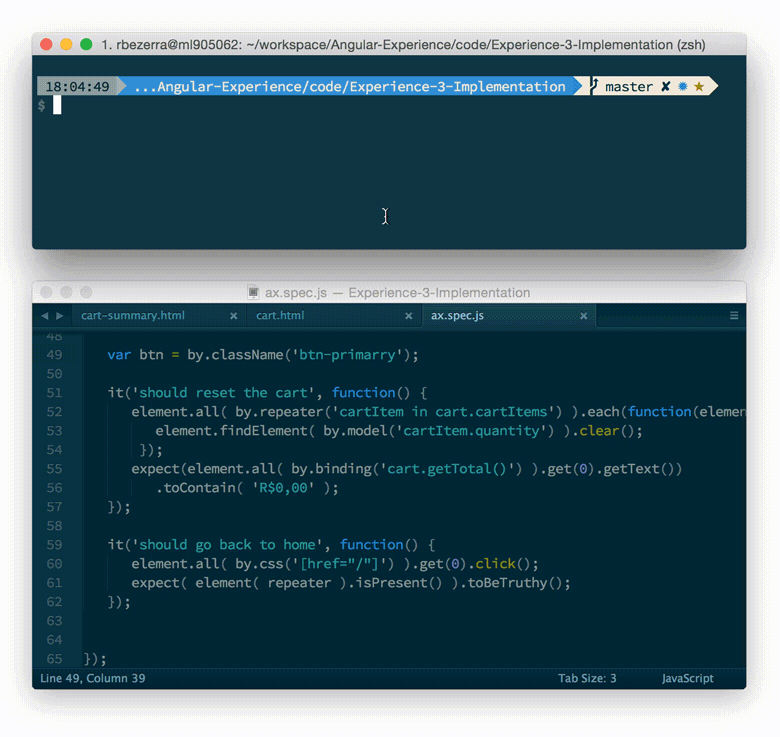Protractor for AngularJS
Writing end-to-end tests has never been so fun
Table of contents
Why is testing so important?
Testing is about gaining confidence that your code does what you think it should do
Whats the idea behind E2E testing?
- How would the users see my application?
- Is my backend communicating with my frontend?
- Can I release this code?
- It does NOT replace Unit Testing!
The dark side of E2E testing
- It needs a specific running environment
- It's hard to write
- It's difficult to debug
- It's hard to keep the tests up-to-date

Protractor is built on top of WebDriverJS
Testing system (NodeJS, Java, etc)
|
Webdriver (a.k.a. Selenium)
|
Your AngularJS App

Reference: Testing AngularJS apps with Protractor
Install
- Download Node.JS
sudo npm install protractor -gsudo webdriver-manager update
Setup a conf.js file
exports.config = {
seleniumAddress: 'http://localhost:4444/wd/hub',
capabilities: {
'browserName': 'chrome'
},
specs: ['example-spec.js'],
jasmineNodeOpts: {
showColors: true
}
};
Write your tests using Jasmine and WebdriverJS
describe('by model', function() {
it('should find an element by text input model', function() {
var username = element(by.model('username'));
var name = element(by.binding('username'));
username.clear();
expect(name.getText()).toEqual('');
username.sendKeys('Jane Doe');
expect(name.getText()).toEqual('Jane Doe');
});
});Protractor global variables
browser:browser.get()elementandby:element(by.model('yourName'))protractor:protractor.Key
Basic example
// example-spec.js
describe('angularjs homepage', function() {
it('should greet the named user', function() {
browser.get('http://www.angularjs.org');
element(by.model('yourName')).sendKeys('Julie');
var greeting = element(by.binding('yourName'));
expect(greeting.getText()).toEqual('Hello Julie!');
});
});
Let's run it?
First things first, open the terminal and start the webdriver server:
webdriver-manager startAfter that, you can run Protractor in another terminal by typing:
protractor test/e2e/config.js // this is the relative path to your config.js fileSearching for elements on the page
element() vs element.all()
Single element
element( by.binding('appName') );Collection of elements
// clicks the 3rd element
element.all( by.css('[ng-click="openPage()"]') ).get(2).click();by.binding
In your test
element( by.binding('myModel') );In your application
<span ng-bind="myModel"></span>
<!-- or -->
<span>{{myModel}}</span>
by.model
In your test
element( by.model('myModel') );In your application
<input ng-model="myModel" />by.repeater
In your test
element( by.repeater('user in users').row(0).column('name') );In your application
<ul>
<li ng-repeat="user in users">
<span>{{user.name}}</span>
</li>
</ul>by.css
In your test
element( by.css('[ng-click="sendMail()"]') );In your application
<button ng-click="sendMail()">Send mail!</button>Find out more in Protractor API
by.select()by.partialButtonText()elementArrayFinder.each()- Full list of available methods
Searching elements best practices
- Take advantage of AngularJS attributes using
by.model,by.repeater, etc - Avoid using potential CSS attributes, mainly IDs and Classes.
Executing events
.click()
In your test
element( by.css('[ng-click="submit()"]') ).click();In your application
<button ng-click="submit()"><button>On Enter Press
In your test
element( by.model('commentText') ).sendKeys("Hi!", protractor.Key.ENTER);In your application
<textarea ng-model="commentText"><textarea>Promises and the Control Flow
Promises based
All Protractor methods are asynchronous and return promises.
// Example of getText() promise
element( by.model('zipcode') ).getText()
.then(function(val) {
var num = val.substring(0, 4);
var isNum = !isNaN(num);
expect( isNum ).toBeTruthy();
});
Control Flow
WebDriverJS maintains a queue of pending promises, called the control flow, to keep execution organized.
it('should find an element by text input model', function() {
browser.get('#/home'); // (1) method browser.get
// (2) method by.binding
var login = element(by.binding('login'));
// (3) method getText
expect(login.getText()).toEqual('User');
});In the example above, the control flow would execute the queue following the sequence we see in the comments. Basically method by.binding would only run once browser.get promise is resolved, and so on.
Debugging using elementexplorer
- Start your webdriver server:
webdriver-manager start - Run:
/usr/local/lib/node_modules/protractor/bin/elementexplorer.js http://angularjs.org - Press 'tab' and play with any element locator.
Maintanable Tests
Best practices to organize your tests
The big picture
- Page Objects - These are the js files where you map the elements and write the functions to perform actions;
- Exports and Require - This is how you connect your Page Objects to your Test Specs;
- Test specs - These are the js files where you write your tests using jasmine syntax.
Tests directory structure
projectfolder/
|-- css/
|-- js/
|-- img/
|-- tests/
|-- unit/
|-- e2e/
| |-- homepage/
| | |-- homepage.po.js
| | |-- *.spec.js
| |-- profile/
| | |-- profile.po.js
| | |-- *.spec.js
| |-- config.js
Page Objects
var AngularHomepage = function() {
this.nameInput = element(by.model('yourName'));
this.greeting = element(by.binding('yourName'));
this.get = function() {
browser.get('http://www.angularjs.org');
};
this.setName = function(name) {
this.nameInput.sendKeys(name);
};
};Node.JS exports and require
Your Page Object filevar AngularHomepage = function() {
this.nameInput = element(by.model('yourName'));
this.greeting = element(by.binding('yourName'));
// ...
};
module.exports = AngularHomepage;
var AngularHomepage = require('./homepage.po.js');
describe('HomePage Tests', function() {
var angularHomepage = new AngularHomepage();
angularHomepage.nameInput.sendKeys('Rafael');
//...
});
Go further!
Separate your tests in various test suites
exports.config = {
seleniumAddress: 'http://localhost:4444/wd/hub',
capabilities: { 'browserName': 'chrome' },
suites: {
homepage: 'tests/e2e/homepage/**/*Spec.js',
search: ['tests/e2e/contact_search/**/*Spec.js']
},
jasmineNodeOpts: { showColors: true }
};
protractor protractor.conf.js --suite homepage
Enable multiCapabilities
exports.config = {
seleniumAddress: 'http://localhost:4444/wd/hub',
multiCapabilities: [
{
'browserName' : 'chrome'
},
{
'browserName' : 'firefox'
}
],
specs: ['example-spec.js'],
jasmineNodeOpts: {
showColors: true
}
};Using onPrepare
Set window size before starting the tests
exports.config = {
seleniumAddress: 'http://localhost:4444/wd/hub',
capabilities: {
'browserName': 'chrome'
},
onPrepare: function() {
browser.driver.manage().window().setSize(1600, 800);
},
jasmineNodeOpts: {
showColors: true
}
};Using onPrepare
Export xml results of your Automated Suites
First, install jasmine-reporters:
npm install jasmine-reportersAnd to keep xml results in Timestamp directories, install mkdirp package:
npm install mkdirpUsing onPrepare
Export xml results of your Automated Suites
//config.js
exports.config = {
onPrepare: function() {
var folderName = (new Date()).toString().split(' ').splice(1, 4).join(' ');
var mkdirp = require('mkdirp');
var newFolder = "./reports/" + folderName;
require('jasmine-reporters');
mkdirp(newFolder, function(err) {
if (err) {
console.error(err);
} else {
jasmine.getEnv().addReporter(new jasmine.JUnitXmlReporter(newFolder, true, true));
}
});
},
};Using params
Your config.js
exports.config = {
seleniumAddress: 'http://localhost:4444/wd/hub',
capabilities: { 'browserName': 'chrome' },
// This can be changed via the command line as:
// --params.login.user 'ngrocks'
params: {
login: {
user: 'protractor-br',
password: '#ng123#'
}
},
jasmineNodeOpts: { showColors: true }
};Using params
Your test
describe('login page', function() {
var params = browser.params;
it('should login successfully', function() {
element( by.model('username') ).sendKeys( params.login.user );
element( by.model('password') ).sendKeys( params.login.password );
element( by.css('[ng-click="login()"]') ).click();
expect( element(by.binding('username') ).getText() ).toEqual( params.login.user );
});
});Using jasmineNodeOpts
exports.config = {
seleniumAddress: 'http://localhost:4444/wd/hub',
capabilities: { 'browserName': 'chrome' },
jasmineNodeOpts: {
showColors: true,
defaultTimeoutInterval: 30000,
isVerbose: true,
includeStackTrace: true
}
};"But, I want to use Protractor in a non-AngularJS app"
Sorry, you can't! :(
Just kidding, of course
you can! :)
You only need to access the webdriver instance by using browser.driver:
browser.driver.findElement(by.css('[data-ptor="submit-btn"]'));
It can be even more elegant
In your config.js
onPrepare: function() {
global.dvr = browser.driver;
}In your test
dvr.findElement(by.css('[data-ptor="submit-btn"]'));Protractor waits for Angular to finish its work
Though you can tell it not to be that smart about your non-Angular app:
beforeEach(function() {
return browser.ignoreSynchronization = true;
});Let's make it more semantic?
In your config.js
onPrepare: function() {
global.isAngularSite = function(flag) {
browser.ignoreSynchronization = !flag;
};
}In your test
beforeEach(function() {
isAngularSite(false); // isAngularSite(true), if it's an Angular app!
});Reference: Protractor - Testing Angular and Non-Angular Sites
Bonus
gulp-protractor-qa
It warns you on the fly whether all element() selectors could be found within your AngularJS view files.

How to use gulp-protractor-qa?
Final thoughts
- E2E testing is a complement to Unit testing
- Avoid using CSS attributes
- Write your tests with scalability in mind
- Just have fun testing with Protractor
Learning Resources
Thank you :)
Thanks to @rafaelbattesti contributions!
